https://www.musical-u.com/learn/discovering-pentatonic-solfa-part-1-exercises/
Have you been looking for a magical tool to transfer the music you hear to the music you play on your instrument?https://www.musical-u.com/learn/discovering-pentatonic-solfa-part-1-exercises/
You Bought a Ukulele… Now What?
Who doesn’t love the ukulele? If you’ve ever brought your instrument to a party, you and your uke were probably the center of attention.
If you’re brand new to learning ukulele, don’t worry, it’s not as difficult as you think! If you want to learn more about playing this fun little instrument, we’ve got everything you need to kick your playing into high gear!
Getting to Know Your New Instrument
You may notice that the ukulele is similar to a guitar, but it’s smaller and has its own distinct sound. The ukulele is composed of three sections: the head, the neck, and the body. The head of the ukulele features only tuning knobs, the neck features frets, fret markers, and a fretboard, and the body features the sound hole, bridge, and saddle. A fret is the strip of metal that goes across your ukulele.

Playing different chords on various frets will allow you to create different sounds. The fretboard is the entire vertical piece on your guitar where the strings are extended and it also features the fret markers, which are small colored circles that help you to remember which fret your fingers are on. Lastly, the bridge and the saddle are where your strings are attached on the bottom of your ukulele.
Getting in Tune
Once you are familiar with the different parts of your ukulele, you need to learn how to tune it! We know that tuning can be a pain and seem like a waste of time, but you’ll quickly realize that if you don’t tune your ukulele, your music will be off-key! Tuning can be achieved with the use of a tuning app on a phone or an electric tuner, but it’s even better if you learn how to tune your ukulele by ear as well.
The first thing to know about tuning is that when you tighten the strings using the tuning knobs, the note will go higher in pitch, and when you loosen them, the note will go lower in pitch. If you’re new to tuning, ask someone else to help you, and remember to be careful when tightening the strings. If you tighten your strings too much you risk ruining them!
 There are several different tunings that you can use. The most common method is G-C-E-A tuning. If you are tuning your ukulele strings to G-C-E-A, you can use the re-entrant or the linear method. Many people choose to tune their ukulele using the linear method, which allows you to open the note range of your uke!
There are several different tunings that you can use. The most common method is G-C-E-A tuning. If you are tuning your ukulele strings to G-C-E-A, you can use the re-entrant or the linear method. Many people choose to tune their ukulele using the linear method, which allows you to open the note range of your uke!
Other tuning methods include slack-key tuning, English tuning, and Canadian tuning. Feel free to research each method and see what works for you. If you have an ear for music, you may find it easy to tune by ear and start with the G chord, re-adjusting each string as you find the correct note.
Holding the Ukulele
Typically, ukulele players strum or pluck strings with their dominant hand and hold it with their non-dominant hand. When you are holding your uke, hold it against your chest and place the body of your uke in the crook of your elbow. You can also make use of a ukulele strap, or rest it in your lap if you are sitting. Don’t forget also to keep your back straight to avoid back and shoulder pain later!
Ukulele Tabs, Chords, and More!
Once you know how to tune your ukulele, or at least have downloaded a phone app, you are ready to learn how to read ukulele chords and tabs.
Chords
A quick refresher: chords are a cluster of notes played together, simultaneously. Ukulele chord diagrams look a little something like this:

On a ukulele chord diagram, there are four lines. Each line represents a string on the ukulele. The G string will be the string on the left side of the tab, and the A string will be the string on the right side of the tab. You also will see circles on each line that tells you on which fret you need to pluck the string. For example, looking at the above chord, there is a circle on the second fret on the leftmost line. That means that you need to pluck the G string on the second fret.
Tabs
Though chords are the more common way of providing written notation for ukulele music, you may come across tabs, too!
Tabs (short for tablature) are simply a way of telling you which strings to play in what order, as well as which frets to play on each string. Here’s an example:
As you can see, there are four horizontal lines, as opposed to the vertical layout of the chords. In tabs, the bottom line represents the G string, and the top line is the A string. The numbers on each line tell you the fret of that string that should be played.
If you see a series of numbers stacked vertically, the tab is indicating to play all these notes at the same time. In fact, you may be looking at a chord! Sometimes, tabs even indicate the name of the chord over a tab.
There are also some other symbols you may see when reading a uke tab, such as an “X”, which means to not play the string at all, or an “O”, which means to play the string open. You may also see an “h” (hammer-on), a “/” (represents sliding), or a “P” (pull-off). As you learn more about reading uke tabs, you’ll also learn the different symbols and what they mean.
Get Practicing!
If you think you’re ready to learn some beginner ukulele chords, try the C major chord, which is by far the easiest chord! You only need to place your ring finger on the A string on the third fret, and that’s it:

Once you’ve mastered C major, try A major. For A major, you will need one finger on the G string on the second fret, and another finger on the C string on the first fret:

Coustii has a ukulele chords for beginners’ guide to get you started. If you’ve just learned how to read ukulele tabs, you can learn new chords by reading uke tabs by yourself!
Putting it All Together
Once you have conquered a few basic chords, it’s time to try some easy songs.
Here are a few songs that everyone will love, and won’t be too difficult for the beginner:
- Stay With Me – Sam Smith
- Sweet Home Alabama – Lynyrd Skynyrd (a classic song for stringed instruments!)
- Margaritaville – Jimmy Buffet (for those who prefer an older sound)
- Whistle – Flo Rida
There are many demos of these songs and others on YouTube so that you can learn quickly by watching others play the song. If you prefer to learn on your own, you can also research ukulele chords or tabs and give it a go on your own!
Another way that you can learn ukulele is by using ear training. Sometimes, people naturally learn to play music by listening and playing the notes that they hear. If it is difficult for you to learn by just using your ears and trying to replicate the notes you hear, you can also use Musical U’s training exercises and resources to be a more natural musician and play by ear.
Stay Motivated: Join A Musical Community!
Whether you are in the beginning stages of learning the ukulele or are just starting to play again, one of the biggest hurdles to overcome while learning any instrument is staying motivated!
It can be very difficult to stay motivated if you feel that you are not making progress and improving. The best way to stay inspired is to keep practicing! Make it easy for yourself by creating a regular routine for practicing. If learning the ukulele is important to you, find time in your hectic schedule for at least 15-20 minutes of practice a day, or create a routine that works for you. See what you can do to keep yourself motivated and learning!
”There is no better way to keep yourself playing than surrounding yourself with other ukulele players. If one uke is good, two or more is better!”
Also, imagine being able to pick up your uke and playing any song you want, just by listening to it a few times. This may be a pipe dream for many musicians, but it’s in fact a very tangible goal! Ear training is a great help in helping you understand chords and find your way around the fretboard, and will help you improve faster with your ukulele.
Musical U will give you both of the above: a supportive community of fellow uke players, and online training and instruction to teach you ear training. By joining, you can benefit by learning how to play by ear, jamming with others, and gaining confidence in your uke skills as well as your ability to improvise! You can even connect with other musicians globally and stay focused on learning. As musicians, it easy to get discouraged, and simply learn chords and songs, but online courses with community support will ensure you master the uke in no time!
The post You Bought a Ukulele… Now What? appeared first on Musical U.
In this audio tutorial, you will learn how to use your ea…
https://www.musical-u.com/learn/music-production-mixed-3-ways/
In this audio tutorial, you will learn how to use your ear training skills in music production and mixing for collaborative projects. Hear how to apply simple tricks in editing, rhythm, and overall feel to improve your music. Finally, check out some helpful tips for your next big project. https://www.musical-u.com/learn/music-production-mixed-3-ways/
If you want to learn music, practise interval recognition…
https://www.musical-u.com/learn/how-to-learn-intervals/
If you want to learn music, practise interval recognition. There are three popular approaches: Reference songs, solfege, and what I like to call “the Nike method”. … it’s time to learn your intervals!
https://www.musical-u.com/learn/how-to-learn-intervals/
Musicians are often told they should “learn intervals”. W…
https://www.musical-u.com/learn/ultimate-guide-to-interval-ear-training/
Musicians are often told they should “learn intervals”. We are told this by our instrument teacher to help us pass exams, by course professors at music college, by ear training tools and websites… But why? What is so important about intervals – and if you do want to learn them, how exactly do you do interval ear training? https://www.musical-u.com/learn/ultimate-guide-to-interval-ear-training/
Five Notes, Infinite Possibilities: the Pentatonic Scale
With a seemingly infinite number of scales available to the modern musician, it can be a little difficult to know where to start!
The major scale may get touted as the most important, but in fact, there is another scale that is even more versatile, pleasant-sounding, and (once you get the hang of it) easy to play.
Introducing…
The Pentatonic Scale
By definition, any scale containing five pitches per octave can be said to be a pentatonic scale. However, for the purposes of this article, we will focus mainly on the major pentatonic scale, whose notes consist of the five most common pitches found in folk melodies and children’s songs.
The major pentatonic scale uses scale degrees 1, 2, 3, 5, and 6. Take a look at the C major pentatonic:
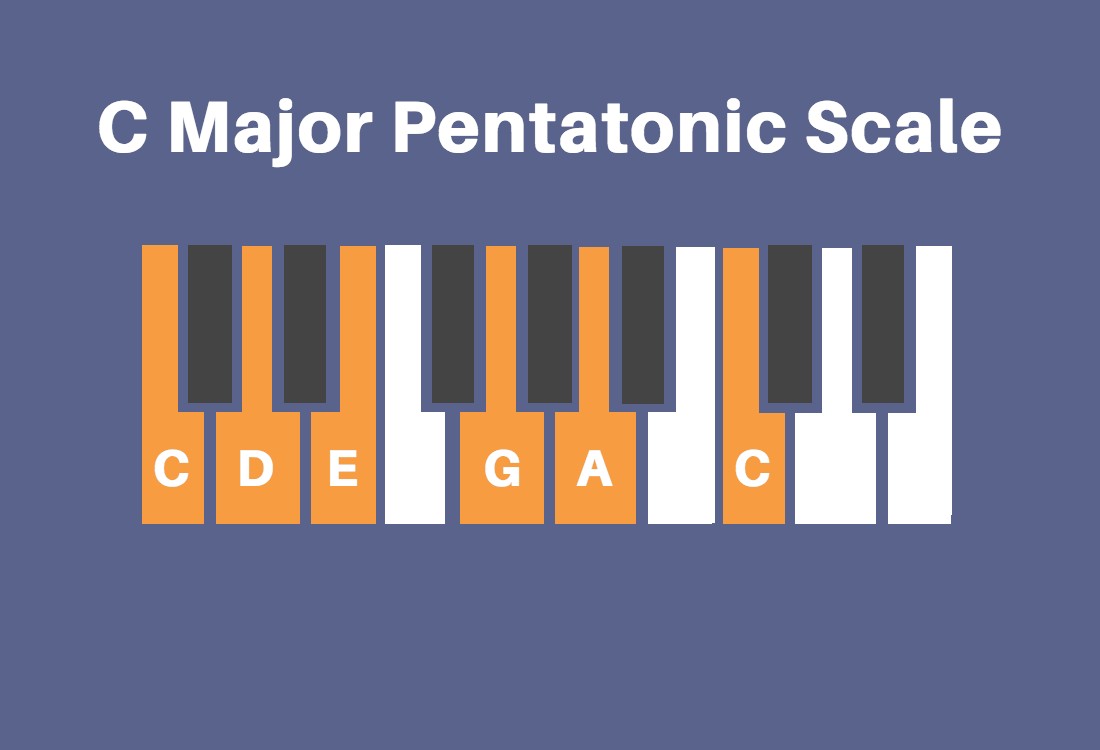
The notes used in the C major pentatonic scale are C, D, E, G, and A.
The scale degrees used remain the same for all pentatonic major scales.
How Does the Pentatonic Compare to the Major Scale?
The major scale, often the first that musicians learn, is built on seven degrees:
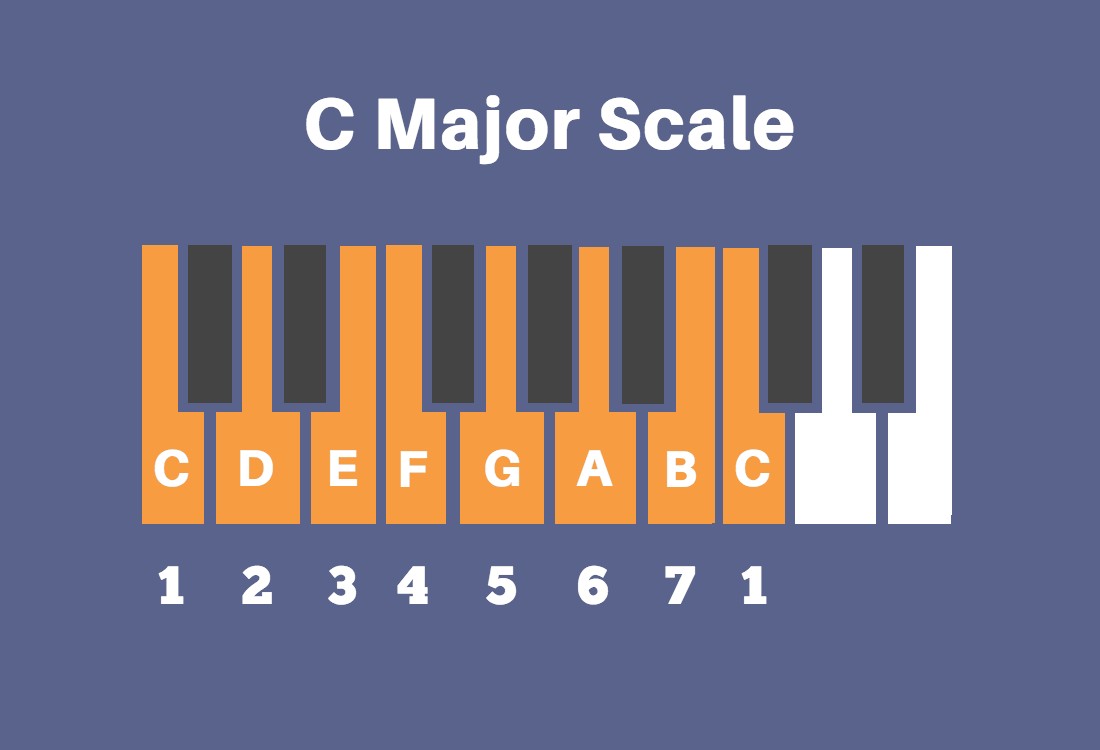
To derive the major pentatonic scale from the major scale, simply remove degrees 4 and 7.
The removal of these in the major pentatonic scale contributes to its consonant (or pleasant) sound. In the major scale, the fourth and seventh degrees form what is called a tritone, which is a fairly sinister-sounding interval (so sinister, in fact, that it was given the nickname of the “Devil’s Interval”!). This interval lends tension and suspense to the major scale.
The removal of these degrees in the pentatonic scale leaves only consonant intervals: a major second, major third, perfect fifth, and major sixth.

Where is the Pentatonic Scale Used?
Well, an easier-to-answer question would be “where isn’t it?”.
The scale has been around for a very long time. Nobody knows exactly how long, but instruments believed to be as old as 50,000 years old have been found tuned to the pentatonic scale.
The major pentatonic scale is ubiquitous in musical cultures all around the world, America, Europe, Africa, India, China, and Japan, to name a few. In fact, the Japanese anthem is based on the major pentatonic scale!
Being a major part of traditional and folk music, the major pentatonic scale carried over into the styles that sprouted from these genres: gospel, bluegrass, and jazz. As these styles further evolved into blues and rock, guess what remained?
That’s right: the major pentatonic scale.
Today, it’s a hallmark of jazz, blues, and rock music, as it offers an excellent improvisational framework for these styles.
Why Learn the Pentatonic Scale?
Blues guitarists aside, this is a must-learn scale for any musician. Here’s why:
1) It’s versatile!
The major pentatonic scale can be used to solo over almost anything. It sounds great over major chord progressions, minor chord progressions, and the 12-bar blues. It even works beautifully with major church modes: that is, the Ionian, Lydian, and Mixolydian modes.
2) It’s easy!
Once you memorize the simple patterns of the pentatonic scale on the keyboard and fretboard, your fingers will be able to play it by memory.
3) It’s already in the music you want to play!
This scale’s ubiquity in popular music means it’s well-worth learning for any musician wanting to cover a famous tune.
Playing the Pentatonic Scale on the Piano
Try this simple exercise: starting on F♯, play an ascending scale using only the black keys on the piano.
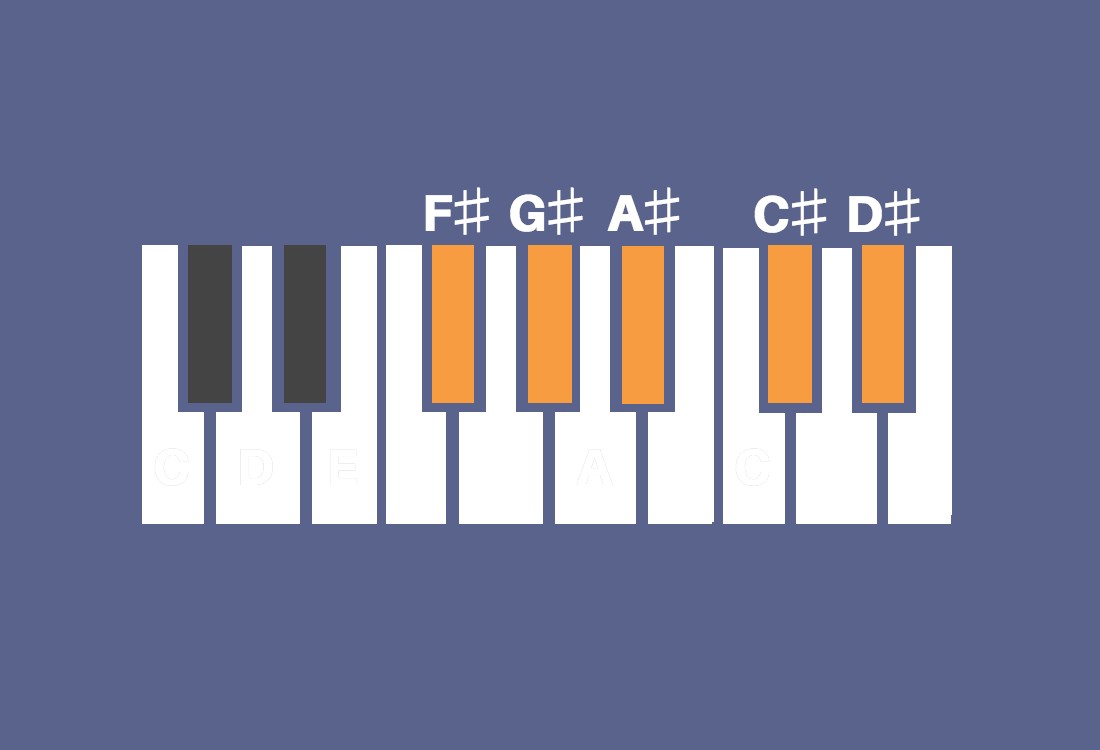
What do you hear?
We’re guessing you would describe the feel of this note pattern as “Asian” or “Oriental”. You have in fact just played an F♯ major pentatonic scale!
To transpose this scale into another key on the piano, simply pick out scale degrees 1, 2, 3, 5, and 6, and play them in ascending order. If you know your key signatures, it’s smooth sailing from there!
Playing the Pentatonic Scale on the Guitar
There are numerous ways of playing the major pentatonic scale, with a single key having several corresponding patterns.
To really master the major pentatonic on the guitar, make use of the CAGED system.
Sounds a bit scary, right?
Fear not! The CAGED system simply gives you five patterns on the fretboard that you can use to play the major pentatonic scale. Each pattern is based on the corresponding open chord shape:
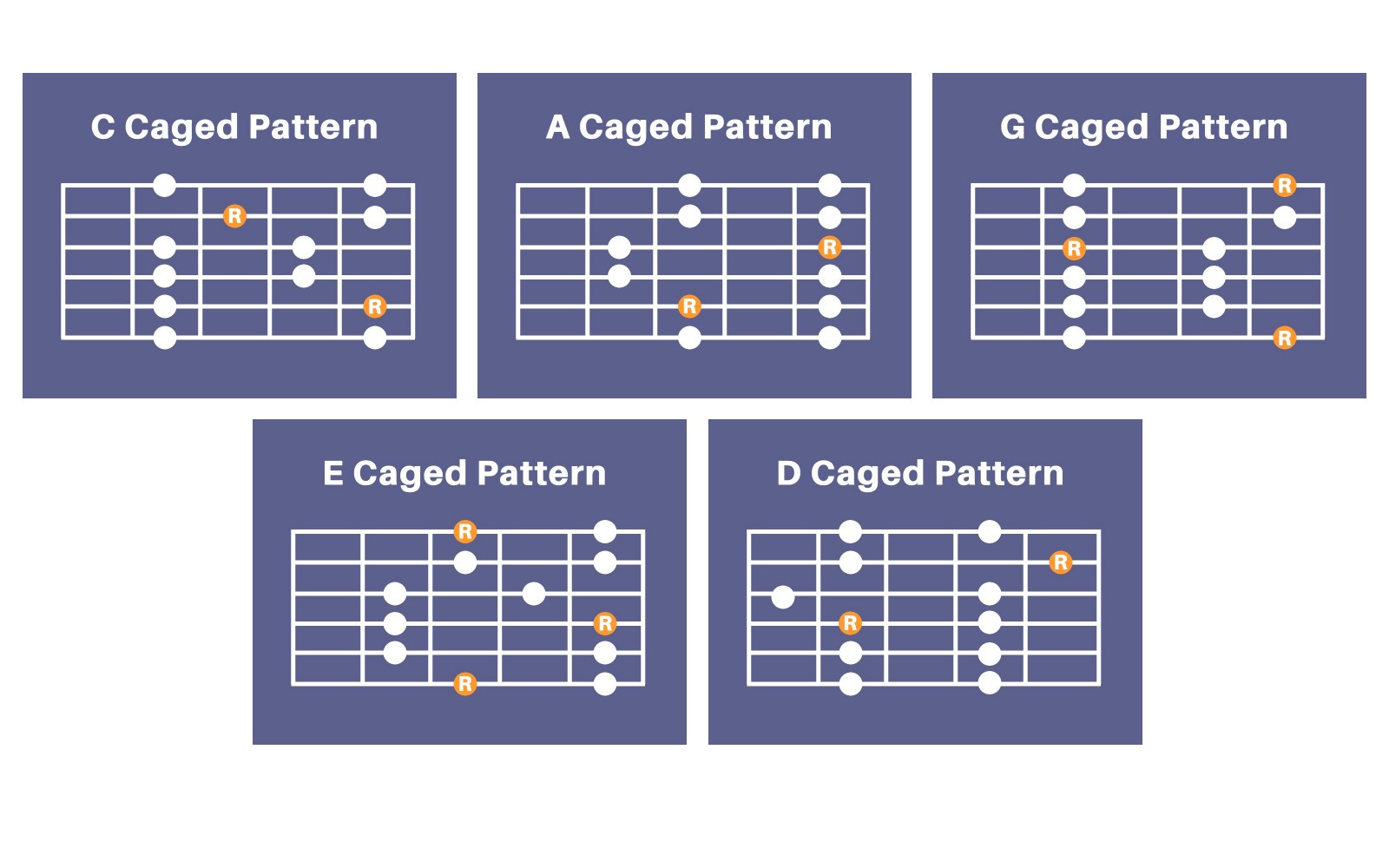
Once you memorize these patterns, all you need to do to transpose the scale into any major key is move up and down the fretboard! The starting position may change, but the fingering pattern won’t.
Beyond the Major Pentatonic
Remember when we said that any scale with five pitches per octave can technically be considered a pentatonic scale?
This means that the major pentatonic scale is far from being the only pentatonic scale!
The Minor Pentatonic
This scale is a great one to learn as a follow-up to the major pentatonic, and can easily be derived.
The relative minor pentatonic scale will contain all the same notes as its major cousin, but will start on a different note. The last note of the major pentatonic will be the tonic of the relative minor pentatonic scale.
For example, seeing as the C major pentatonic ends on A, the relative minor pentatonic scale will be A minor:
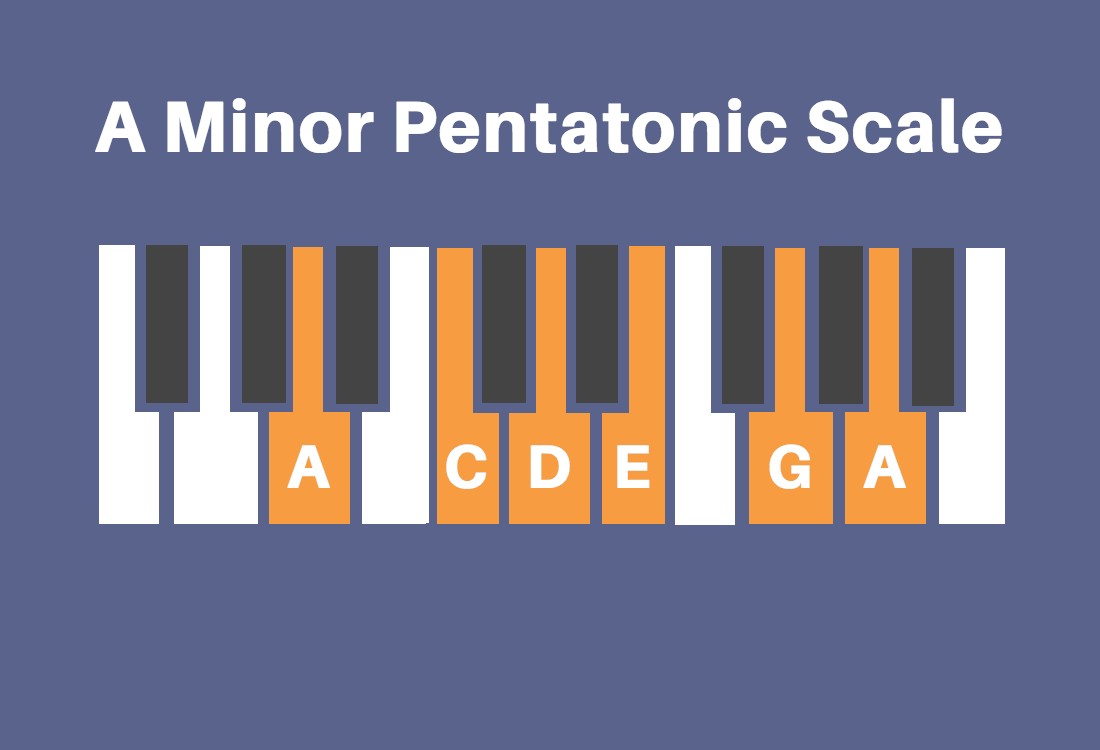
Other Pentatonic Permutations
If the only true requirement of a pentatonic scale is the presence of five pitches per octave, there are thousands of possibilities! Try building your own unique pentatonic scale by raising, lowering, and shifting pitches. With so many possible combinations, you’re bound to find something that sticks in your head.
Get Playing!
Now that you’ve seen the versatility of pentatonic scales, it’s time to add them to your repertoire!
Start small: take a second, pick up your instrument, and try out the C major pentatonic.
Scales can be the bane of a musician’s life. At Musical U…
https://www.musical-u.com/learn/how-to-make-scales-less-boring/
Scales can be the bane of a musician’s life. At Musical U we teach an approach called the MAGIC framework for goal setting which helps to ensure you set truly motivating and effective goals in your musical life. Two important aspects of that are making your goals musical and making them interesting. https://www.musical-u.com/learn/how-to-make-scales-less-boring/
When you first start exploring the world of musical ear t…
https://www.musical-u.com/learn/3-keys-to-fast-ear-training-success-from-scott-edwards-ear-training-hq/
When you first start exploring the world of musical ear training, it’s easy to get lost in all the different approaches and conflicting advice out there. We invited Scott from Ear Training HQ to talk a bit about his top tips for making fast progress with ear training. https://www.musical-u.com/learn/3-keys-to-fast-ear-training-success-from-scott-edwards-ear-training-hq/
Musical U’s 10 Mini Songwriting Challenges
Songwriting is a tricky business. Inspiration can be hard to come by – and even then, fitting your thoughts and feelings into words, and squeezing those words into music can be a process akin to pulling teeth. Sometimes, though, all you need are a few simple exercises to sharpen your songwriting skills!
Look no further than these 10 songwriting mini-challenges. Each one focuses on one or two specific skills necessary for any serious songwriting musician. As musicians, we need to challenge ourselves to achieve the next level of musicianship, and this includes sharpening our writing skills.
These fun musical exercises are guaranteed to help you:
- Think outside the box
- Develop skills like writing melodies and lyrics
- Help you come up with new material
- Build your musicality
Make your songwriting challenge extra fun by having a friend, your band, or your online music community join in to share and collaborate!
Many of these challenges are adapted from Composer Boot Camp 101: 50 Exercises for Educators, Students, and Music Professionals, a useful practical guide to songwriting and composition for any level of musical skill.
Song Challenge #1: Superhero Song Challenge
 From Superman to Wonder Woman to Daredevil and the Flash, every superhero has his or her own specific abilities, weaknesses, and overall look. Not only that, but many of the superheroes have their own distinct theme song thanks to a plethora of hit films and TV series associated with the character.
From Superman to Wonder Woman to Daredevil and the Flash, every superhero has his or her own specific abilities, weaknesses, and overall look. Not only that, but many of the superheroes have their own distinct theme song thanks to a plethora of hit films and TV series associated with the character.
In this exercise, you will write a short song based on a random superhero. The song can have lyrics or be purely instrumental. This is a great way to challenge your creativity and really see how you can take any subject and make a fun song out of it.
Here’s how:
- Write the names of eight superheroes on notecards.
- Put the notecards in a box.
- Randomly select one card.
- List three main characteristics of this superhero (for example, strong, slow, fast, green, genius).
- Using your instrument or voice, create a short one-minute song based on this character in a day.
For this challenge, you can write a fun pop tune, an epic filmscore, a guitar solo, or whatever else you can imagine:
A Superhero Sample
Inspired by the Flash, I decided to write a very simple bass line that is reminiscent of some of the more popular superhero film scores popular in the theaters. Knowing the story behind the Flash, a teen struck by a particle accelerator leading to abnormally fast running speeds and healing (as well as the ability to jump into parallel universes), I wanted to create a song that had a musical motif that pushes forward like the Flash running to save the city.

After writing the initial bassline, I added in some extra software patches to add a touch of sci-fi and an “epic” feel to the tune. Being a song challenge, this is a rough mix, but it gives you an idea about the possibilities.
Justice League Super Mini-Challenge
For extra fun, have each of your friends select a different superhero and meet again the next day (or week, if that works better). Jam out on your new superhero tunes and chat about the merits of each song.
Song Challenge #2: Let Art Inspire You
For this mini-song challenge, you will let art inspire you. Just like classical composer Modest Mussorgsky wrote “Pictures at an Exhibition” after seeing the art of Viktor Harmann, you will allow what you see with your eyes influence your work.
You can use any type of visual art to inspire you, whether it is a mixed media piece at a gallery, a painting at the local museum, manga art, or even a confusing collage of cute cats from the internet. The point is to truly allow what you see create new inspiration for you.
Here’s how:
- Select a piece of art.
- Truly study the work of art for 30 minutes or more.
- Write down feelings, thoughts, and memories that you come to you as you look at the artwork.
- Develop a melody that matches the artwork.
- Jot down the melody.
- Develop the melody into a short one-minute song, with or without lyrics.
You’ll find yourself pleasantly surprised with the music you come up with! Mussorgsky wrote “Ballet of the Unhatched Chicks” from this sketch of theater costumes:
Song Challenge #3: Melody in 3 Ways
For this challenge, take a short melody from one of your favorite bands or songs (or come up with your own), and rewrite it in a number of styles. For example, you might pull out the hook from Lady Gaga’s “Pokerface” and rewrite it as a love ballad, a country song, or a heavy metal tune. Or maybe you can write it as a polka… the “Pokerface Polka”:
Whatever direction you go with the melody, be sure that you:
- Are true to the melody
- Are true to the musical style
- Have fun creating a new tune using a familiar melody!
For example, you can use a familiar melody like the opening motif to Beethoven’s 5th Symphony:

This is a very familiar musical motif that has been used countless times in a variety of styles, including disco. Using this as an idea, you might mix down something like this:
Song Challenge #4: Superspeed Melodies
For this song challenge, you will need a timer and sheet music or music software program like Finale or Logic. If you don’t know how to notate music, just record your voice using a smartphone or other recording device.
Here’s how to write your superspeed melodies:
- Set the timer for 15 minutes.
- Create as many unique melodies and motifs as you can until the timer buzzes.
The melodies can be as short as three notes or as long as you want, but the key is to try to come up with something different and original in a very short amount of time. After you are done with your superspeed melodies, play through them, circling ones that you might want to keep for later use!
Here are examples of simple melodies that you might come up with in this exercise:
Pro-Tip: Watch out for accidentally “borrowing” from famous tunes in this exercise. This is something that every songwriter has to watch out for when writing a new song. It might be interesting to note how many of your notes might just belong to someone else!
So after you finish your mad dash at melody-making, listen for any familiarity between the tunes you developed and ones that you have heard on the radio, on TV, or even from your kid sister’s punk band!
Song Challenge #5: Random Lyrics
Most of these songs can be adapted to instrumental music or vocal music. But for this exercise, you will challenge your lyrical skills.
Here’s how:
- Go to the local library or bookstore.
- Enter the nonfiction aisle and spin around three times.
- With your eyes closed, select a book and open it to a random page.
- The first paragraph is your inspiration for your song.
- Write a short song based on the selection, trying to stay as close as possible to the original text.
In this example, the composer had to write a classical ensemble piece based on a passage from an antique physics book about the atomic bomb.

Song Challenge #6: Postcard Song
For this mini song challenge, you are going to write lyrics based on a postcard. If you don’t have a collection of postcards to use, you can print several online or use a site that has a random image generator. The image does not have to be a location. It could be something fun, serious, sci-fi, romantic, horrific, an animal, etc. The point is that it is an image that you might not see on a regular basis.
Then:
- Select an image (either a postcard or an online image from a random image generator).
- Write down a few different ideas, feelings, thoughts, and words that come to mind when looking at the image.
- Write down a short stanza for a song based on the image.
- If you feel really inspired, write out the lyrics for an entire song.
- Share your lyrics with the world via social media, an open mic night at a coffee house, or with your bandmates.
The lyrics below were inspired by this interesting random image of a smiling shaving cream face:
“Ode to a Shaving Cream Face”
 (With a Jazz Swing)
(With a Jazz Swing)
My smiling shaving cream face
Soft and gushy, full of grace
A little bizarre and out of place
But still, what can I say?
You bring sunshine to a room
Wash away all that gloom
With your smuggy funny muggy
Oh, I how love you, Honey
So keep on smiling
Don’t get down
Cuz when you are around
You are my smiling shaving cream face!
Song Challenge #7: Film Music Challenge
So far, the mini song challenges that we have done have focused on skills like writing melodies and lyrics. This next mini-challenge develops your harmonic skills. To complete this mini songwriting challenge, it will be helpful to have an instrument like a piano or guitar for chord progressions. You will select five short film clips and quickly improvise your own original score using chords.
Here’s a helpful guide for the genres that certain chords and scales are best suited to:
- Minor chords: sadness, mystery, suspense, horror
- Major chords: comedy, happiness, happy endings, children’s movies
- Jazz chords: Film Noir, mystery, historical films, romantic
- Whole tone scale: outer space, science fiction, weird, suspense
This is just a short list of harmonic ideas. There are literally thousands of harmonic and melodic ideas that you can use for this mini song challenge!
For example, this short piano sample is based entirely on C minor. You can hear how “scary” and full of suspense it sounds:

Here’s how to compose your own original movie score:
- Select five short one-minute film clips from different film genres such as comedy, mystery, or sci-fi.
- Mute the volume.
- Underneath the scene, improvise different harmonies that fit with the clip.
- Try to have the harmonic choices match the scene.
- Record your improvisation and sync to the film clip.
- Share with your friends!
If you don’t have access to a guitar or a piano, you can always use your voice, percussion, or even virtual instruments on your smartphone for this mini-challenge. The key is not the instruments used, but the way that you can develop musical ideas to fit a film.
The piano example below was created as a song challenge for this short horror clip. Taking the musical ideas based on C Minor, I then fully orchestrated the short tune with a full string orchestra patch, pizzicato strings, and a bell synth. Because this is just a challenge, this is a rough mix, but you can hear how you can take a simple piano idea above and develop it into a full cinematic track:
Remember that you don’t necessarily have to create an entire instrumental track. You can just create a fun pop tune or other type of soundtrack for this example.
Song Challenge #8: Musical Food Challenge
Many favorite song challenges like the 50/90 Song Challenge, where you write fifty new songs in ninety days, have a specific time limit and challenges based on topics. For this fun mini-challenge, you are going to write a song each day based on what you eat for lunch for seven days straight. It might sound a little zany, but it will force you to really come up with some original ideas (and maybe some original lunches).
Get a little inspiration for this musical food challenge from song challenge guru Jonathan Mann, who has written a song a day for years, leading to worldwide infamy for his quirky and fun songs:
He even managed to sneak in a full recipe into a song, ensuring that you’ll never forget how to cook this wholesome breakfast:
Song Challenge #9: 10 Songs About a Girl (or Guy)
We all love the love song, right? Okay, well, maybe not, but even if you don’t have a favorite guy or gal to write about, you might have a pet, best friend, or even grandmother that you care about a lot and want to immortalize forever through song. Ten songs, that is.
While this challenge works best with lyrics, you can opt for instrumentals if that is more your forte (pun intended):
- Choose a person (or pet) that you cherish.
- Every three days for a month, write a song dedicated to this person, for a grand total of 10 original tunes.
- Record the songs, and if possible, share your undying musical devotion with them (and let us know how it goes!).
Song Challenge #10: Happy/Sad/Crazy/Mad
This is a pretty easy mini-challenge based on emotions. You will need to write each of these emotions on a different notecard:

- Happy
- Sad
- Crazy
- Mad
- Afraid
- In love
- Excited
- Lethargic
- Hopeful
- Disgusted
- Surprised
- Lonely
- Meditative
These are a good bunch to start with, but you might find that once you start writing you will end up with dozens of more emotions for this mini-challenge.
For this challenge, you need to write seven songs in seven days based on emotions. You can opt to use only one emotion for the tune or choose two cards to really challenge yourself. For example, you could end up with a tune that has a “lonely” lyrics but has a very “excited!!!!!” chorus.
Here’s how:
- Randomly select one or two cards (for example, happy and surprised).
- Think about what words come to mind when you think about these emotions.
- Write out a title first.
- Write a short tune based on the card(s).
BONUS: Death Metal Mini-Challenge
 For this fun challenge, you will write a song based on a death metal title.
For this fun challenge, you will write a song based on a death metal title.
- Go to the Death Metal Title generator.
- Click the “another album!” button.
- Select one of the song titles to create a new tune.
Seeing Musical Inspiration Everywhere
So, how did you do on our fun mini songwriting challenges? If you want to challenge yourself further, check out this great article on improvisation and our article on other fun song challenges.
These songwriting challenges all aimed to help you see inspiration in everyday objects and experiences. Take this idea and run with it even after you complete these mini-challenges! You never know when another brilliant song idea may hit you: maybe while you’re stuck in traffic? Cooking a family meal? Walking your neighbor’s dog?…
The post Musical U’s 10 Mini Songwriting Challenges appeared first on Musical U.
Here is an interesting fact: when you train your ear for …
https://www.musical-u.com/learn/hearken-unto-this-one-reason-to-learn-foreign-languages/
Here is an interesting fact: when you train your ear for musical purposes, it opens up for languages, too! Although music can help with foreign languages and ear training opens your ear up in general, what about the other way around?
https://www.musical-u.com/learn/hearken-unto-this-one-reason-to-learn-foreign-languages/

